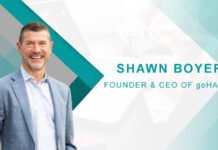Hi Simon, it’s great to have you at HRTech Cube! Can you share your professional journey and what led you to develop HR technology, particularly in payroll systems?
Much of my past professional experience was in finance, where I’ve seen how different technologies shape the industry. However, the payroll vertical remained stagnant where many accountants are still inundated with paper-heavy and antiquated processes. Observing this innovation gap, it inspired me to build a solution to address it during my time at my previous startup, which offers a variety of HR solutions, including one for payroll.
At Nmbr, we wanted to take the extra step in not just improving payroll processes, but also allowing businesses to offer their own, embedded payroll solutions. Embedded payroll and our payroll API enables companies to build high-quality products for their customers, which is exciting a unique opportunity.
Throughout your career, what common pain points have you observed in traditional payroll systems, and how have they impacted organizations?
Mostly driven by paper and legacy software, traditional payroll systems are fragmented and disconnected from the organization’s people management system. This often leads to inefficiencies and errors, causing mismanagement of funds and potentially negatively impacting employee satisfaction among those who are affected.
In your opinion, how do reliable payroll systems contribute to overall employee satisfaction and engagement in the workplace?
Reliable payroll systems are the bedrock of trust between employers and employees. When workers can count on accurate, timely compensation, it reduces stress and allows them to focus on their jobs. This reliability fosters a positive work environment, boosting morale and productivity. Ultimately, a smooth payroll process signals that a company values its workforce, which is crucial for retention and engagement.
With the evolving landscape of payroll technology, where do you see payroll heading in the future, particularly regarding embedded solutions and offerings from non-HR companies?
The next evolution in payroll technology is embedded solutions, addressing the increasing need for intuitive, all-encompassing tools while opening new avenues for software providers. These integrated systems allow developers to incorporate payroll functionality directly into platforms that already house essential employer data, eliminating the need for cumbersome and error-prone data exports. As businesses accelerate their digital transformation efforts, embedded payroll is poised to become a cornerstone of contemporary workforce management, delivering advantages to both employers and their staff.
What innovative features or trends do you think are most important for modern payroll systems to address current market needs?
As someone deeply immersed in the payroll and HR technology space, I believe that modern payroll systems must focus on continuing to make the process faster and more efficient to effectively address current market needs.
First, real-time payments are becoming increasingly important, especially with the rise of gig economy workers and flexible pay schedules. Additionally, AI-driven compliance is essential for automating the management of ever-changing tax laws and regulations, reducing errors and ensuring adherence. Lastly, strong integration capabilities are crucial, allowing payroll systems to seamlessly connect with other HR and accounting tools to create a unified ecosystem for business operations.
As the CEO of Nmbr, what are some of the key strategies you’ve implemented to differentiate your payroll solutions in a competitive market?
We enable other companies to build their own payroll solutions, so we are not directly competing with the likes of ADP, Dayforce, etc. However, it’s that combination of our infrastructure with existing high value software offerings that make for our client’s competitive edge. For instance, one of our early partners has a beautiful and intuitive system for managing complex union agreements. Most standalone payroll software struggles in this area but that partner was able to build something truly incredible and extremely unique by combining their existing system with our payroll infrastructure.
What personal strategies or habits do you employ to maintain a clear vision and drive growth within your company?
Being concrete, being committed, and being transparent. I try to ensure I am clear with myself and with the team about where we want to be in 10 years, and what it will take to get there. Ten-year goals are usually very ambitious, and in our case that’s true as well. Oftentimes, ambitious long term goals are easy to set aside in favour of the most pressing near term work. And while the near term work is certainly priority #1, as a habit or practice I force myself to commit space to continue chipping away at the longer term goals at the same time. Writing down that strategy and sharing the iterative progress with the team in a regular and transparent manner is key to helping the entire team stay aligned with that vision, and everyone’s eyes and input further enable us to stay on track.
What advice would you offer to entrepreneurs looking to enter the HR tech space, especially those focusing on payroll solutions?
My key advice would be to ruthlessly prioritize your time and focus. It’s crucial to identify the activities that drive maximum impact for your business and concentrate on those. This often means saying ‘no’ to more things than you might be comfortable with initially.
It’s tempting to try and do everything, especially in the early stages of your startup. However, this approach can quickly lead to burnout and inefficiency. Instead, analyze your daily tasks and determine which ones truly move the needle for your business. Once you’ve identified these high-impact activities, strive to eliminate or delegate almost everything else.
While it’s important to be hands-on, especially in the beginning, avoid taking on roles that aren’t central to your position as a founder. For instance, handling customer support in the middle of the night (unless absolutely necessary) isn’t the best use of your time and energy as a CEO. Build a team and systems that allow you to focus on strategic leadership and growth.
Looking ahead, what are your main priorities for Nmbr in the next few years, and how do you plan to adapt to changes in the payroll industry?
Looking ahead, our main priorities for Nmbr in the next few years are centered on solidifying our position in the Canadian market and adapting to the evolving payroll industry.
To adapt to industry changes, we’re focusing on innovation and continuous improvement, staying closely attuned to customer feedback and industry trends. We’re committed to agile development practices that allow us to quickly respond to new regulations, technological advancements, and shifting business needs. By maintaining this flexibility and customer-centric approach, we aim to not only adapt to changes in the payroll industry but to lead the way in shaping its future in Canada.
Is there anything else you’d like to share with our readers about your journey, the mission of Nmbr, or the future of payroll technology?
Our ambitious goal is to power approximately 50% of all payroll products in Canada by the end of next year. To achieve this, we’re doubling down on our investment in robust infrastructure and developing cutting-edge products that precisely meet our customers’ needs.
Gain Invaluable Insights from HR Tech Leaders. Read Exclusive HrTech Interviews and Discover the Future of Work.

Simon Bourgeois CEO of Nmbr
Simon Bourgeois is the founder and CEO of Nmbr, Canada’s first embedded payroll software. Before starting Nmbr, Simon founded multiple technology companies, including OneLocal and Humi. Now, he is shaking up the payroll industry by making it possible for businesses to embed Canadian payroll functionality into their products in just days or weeks.












